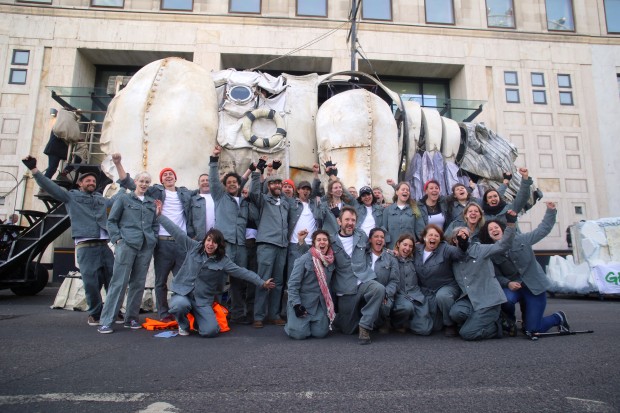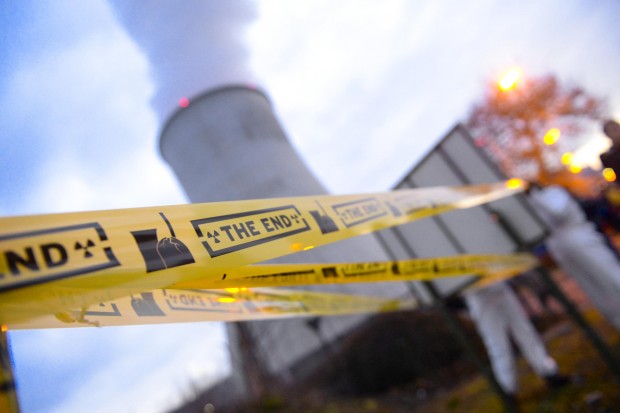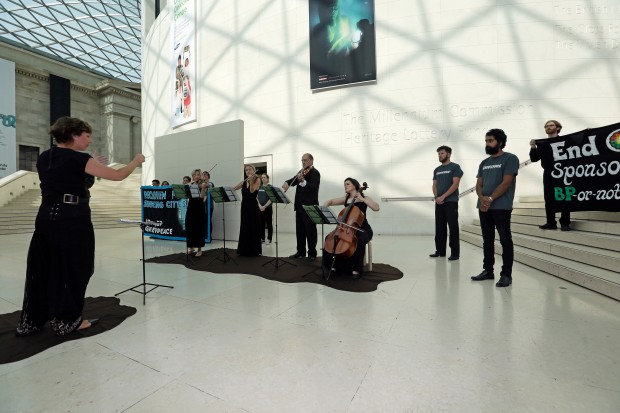Six Greenpeace Non Violent Direct Actions
Greenpeace volunteers are regularly invited to take part in Non Violent Direct Actions (NVDA). These are an important part of how we campaign, and they are not undertaken lightly – as they usually involve some risk of arrest. Here are six illustrations of the sort of actions volunteers have been invited to take part in, for your consideration.
If you are applying to attend a NVDA training course, try to imagine what taking part would really be like. Think about the issues, about the risk of arrest and the early morning starts, but also the contribution these actions make to winning Greenpeace campaigns.
1. Kingsnorth – Shutting Down a Coal Fired Power Station

In October 2007, just after 5am, approximately 50 Greenpeace volunteers took over a little known coal fired power station in Kent. One team immobilised the huge conveyor belt carrying coal, and then chained themselves to the machinery. Another team climbed onto the plant roof (as illustrated), while a smaller group climbed a 200m ladder up the inside of the chimney. A smaller team occupied the jetty using a roll-up inflatable.
Outside the plant a 4th team acted as decoys for the plant security at the main gate, and then proceeded to leaflet the staff, as to why Greenpeace had taken this action. Away from the plant three other teams leafleted the towns around Kingsnorth, and a host of other volunteers were involved in support roles.
When the action was over there were a total of 24 arrests. Arrested individuals were detained for up to 24 hours, were photographed, fingerprinted and had their DNA taken. Subsequently 18 volunteers pleaded guilty at the magistrate’s court, receiving a mixture of fines and community service. The trial of the 6 remaining activists, and the jury’s not guilty verdict became worldwide news and the subject of a Nick Broomfield documentary.
2. Polar Bears Occupy Cairn Energy’s Headquarters

In July 2011, 60 activists (50 of which were dressed as polar bears) occupied Cairn Energy’s Edinburgh headquarters. Their purpose was to look for Cairn’s elusive ‘Arctic oil spill response plan’, and to take supporter messages to the heart of the company.
Activists barricaded themselves in rooms and locked-on to desks and each other. Police used angle-grinders to remove locked-on activists. Multiple arrests were made and 17 activists appeared in court in connection with the protest.
3. Aurora Visits Shell

In September 2015, a polar-bear puppet named Aurora, the size of a double-decker bus, walked to Shell’s Head Quarters in London to protest their drilling for oil in the Arctic. 64 activists accompanied Aurora; some puppeteering the giant bear and others blocking traffic and marshalling the train of activists. Once Aurora was installed outside Shell’s HQ, 6 activists locked onto her at various points, while others continued to animate her head and omit her thunderous roars. Other activists leafleted Shell staff and members of the public, continued to marshal or took social media roles: filming, tweeting and sharing their experiences. Aurora and her Greenpeace activists were joined by Emma Thompson and First Nation activist/artist Audrey Siegl.
A significant police response had been anticipated, however, police presence was minimal and no arrests were made. Aurora remained outside Shell’s HQ for a month, staffed day and night by activists and volunteers. At the end of her monthly stay, Shell announced that they would end all oil-drilling in the Arctic.
4. Masking Monuments

In April 2016, 26 activists placed custom-made air pollution masks on various prestigious London statues, including Nelson’s Column and 14 others. Activists worked in teams focusing on different statues around the capital. Ground teams assisted climbers with ladders and equipment. The protest was the first intervention of the Air Pollution campaign, protesting dangerous and often fatal levels of air-pollution in the city.
8 arrests were made. Activists were taken to various London police stations, where they were photographed, fingerprinted and had their DNA taken. They were held for a few hours before being released on bail. Some activists were charged. The charges were later dropped.
5. No to Nuclear: a European Mass-Action

In March 2016, 12 UK activists travelled to Belgium and shutdown a nuclear power plant as part of a mass-action involving nuclear plants in 6 European countries. The UK activists were part of 240 from all over the globe. Their aim was to urge governments to close down ageing reactors on safety grounds.
Protesters dressed in orange jumpsuits scaled boundary fences at plants in France, Belgium, the Netherlands, Switzerland, Sweden and Spain and hoisted large banners with images of cracking reactors and projected the words “The End” onto walls. 3 UK activists were arrested due to having higher risk roles (1 was a climber and the 2 others had climbed the fence into the nuclear plant).
6. A Musical Communication

In September 2016, Greenpeace activists partnered with ‘Art not Oil’ activists to facilitate a string quartet performance of ‘Requiem for Sunken Cities’ in the foyer of the British Museum. Musicians performed on felt oil-slicks and activists held up banners and engaged with members of the public, calling on the British Museum to end its BP sponsorship. As part of the performance, supporter petitions were handed to the museum. Simultaneously, Greenpeace campaigners met with British Museum officials to discuss the sponsorship deal. There were no arrests.
Get Involved
Read more about how you can get involved with Greenpeace on the Get Active Page, the lobbying network page, or if you’d like to recieve the e-geactive newsletter then please join our webgroup
